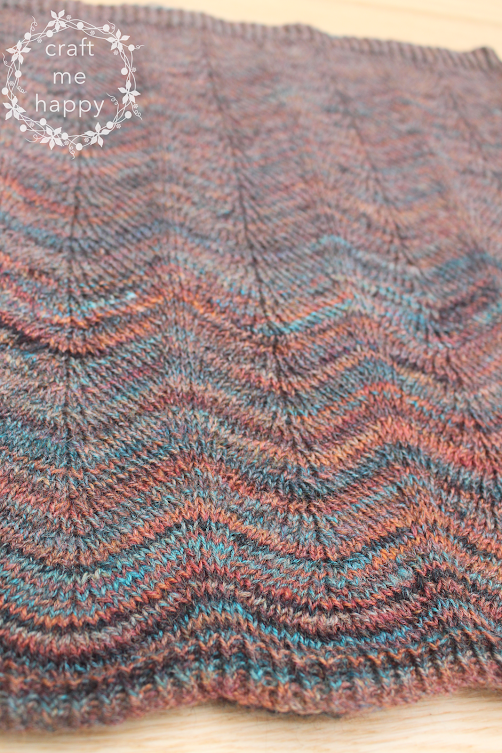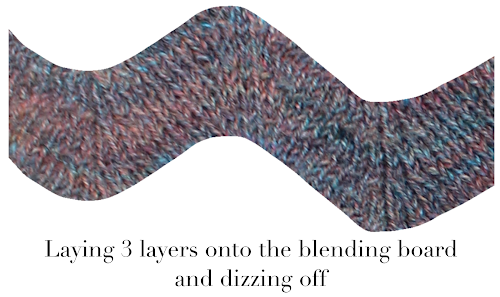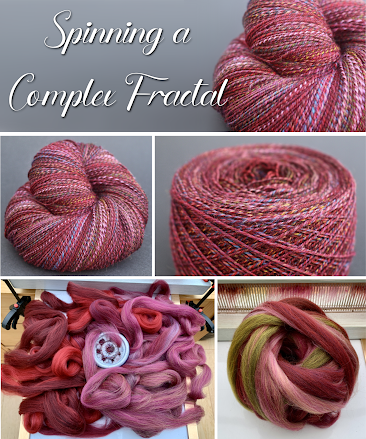I recently wrote a blog post in which I experimented with many different ways of preparing and spinning a mill-blended, multicoloured top. I wanted to find out the best techniques for preventing the colours from completely blending together into a muddy brown or grey.
I learned so much by just allowing myself to play with fibre. I worked out which methods worked best for me, which yarns I preferred, and which methods I found were really way too much effort for anything but the smallest of projects!
 |
| 9 of the yarns I spun showed at least 'pops of colour', while 2 (not pictured here) were almost totally brown throughout |
----
In spinning up 11 different yarns, I produced nearly 300 grams of yarn in varying levels of blendedness (I'm just making up words now!). I wanted to see how all of the yarns looked knitted together, in order of how blended I think they are.
I didn't have enough yarn for a sweater, so I knitted myself a kind of oversized cowl. It was a really useful exercise as it helped me to see how the colour transitions worked over a much larger (and more realistic) number of stitches. It also made me rethink which techniques I would use in a sweater spin.
The section that was spun from the fold also stands out a little too much for me. Most of the other yarns are slightly muted, but the colours in the yarn spun from the fold seem to have retained their original hue, but are scattered around randomly in a way that could be distracting: I liked this technique, but I think I would reserve its use for more analogous colour blends.
Some of the later, more blended sections do look very similar to each other, so I would probably remove a few of those too.

You can see with this one, the colours are starting to come into focus a little more and there is a little less brown than in the previous yarns.
5
I would love to knit a top-down sweater using this Spinning into Focus method, working from the most blended at the neckline, down to the least blended at the bottom rib.
I tend to avoid sweater spins as I find them a little monotonous, but if I were to break it up into 6 or 7 smaller spins, I think that would definitely hold my attention. I would also have 6 or 7 yarns that were certain to complement each other as they would be spun from the same multi-coloured fibre.
Here's a closer look at how I think I would divide up my yarns for a Spinning into Focus sweater spin -
1

I didn’t actually include this one in my original blog post as I felt that the colours were much too blended to be helpful. As the description says, instead of lashing the fibres onto the hackle, I drafted them on carefully, trying to lay the colours down on top of each other. I then dizzed off a thin roving. It still came out very well blended, but this yarn is probably very similar to the yarn you would get if you pre-drafted all of your fibre and then spun it from the end. It has a little more depth and complexity to it than the one that was randomly lashed onto the hackle.
2
Unfortunately, the close-up of my knitted sections appear slightly out of focus when I zoom in, but please be assured that spinning from the tips of the fibre, moving slowly from side to side, gave me a very subtle tweedy effect.
Here's a close-up of how I spin from the ends of undrafted top, moving slowly from side to side for subtle colour transitions.
3
There were a few yarns that had this level of subtle colour blend, so I've reduced them down to this one as laying on several layers of fibres onto the blending board made it much easier to diz off.
4
This was probably my favourite technique, as it was quick and simple and gave a lovely blend of muted colours.
Here's a video of this method in more detail -
6
This is already a very popular method for avoiding spinning mud. If I was splitting it for a sweater spin I would probably break off much longer lengths, but still arrange the colours randomly so that it fitted in with the other irregular colour transitions.
7
Although this method took significantly longer than any of the others, I decided to include it, as I think its boldness would make a striking stripy rib trim, and finish off a Spinning Into Focus sweater beautifully.
___
I humbly offer to the spinning world my Spinning Into Focus technique. I'm definitely going to use this method the next time I buy a multicoloured blended top with the intention of knitting an easy, top-down, seamless sweater. It would certainly keep my attention longer, the 7 different yarns would all complement each other, and I'd have a jumper that was unquestionably unique and handspun.
If you have found this post interesting or useful, please consider pinning it to Pinterest. It makes a big difference and it helps other spinners find it too.
At this point, I normally suggest similar related blog posts, however, my list of spinning-related content is becoming a little unmanageable... If you'd like to read more blog posts about spinning and fibre preparation, please take a look at this page here where you will find links to all of my spinning and fibre articles.
Thank you for reading, and happy spinning!
---
Other Spinning Related Blog Posts
 |
| 9 Different Ways of Spinning a Multicoloured Blend While Trying to Avoid 'Spinning Mud' |
----------
Please be sweet and share the love. Leave a comment, subscribe to my YouTube channel, like my Facebook page for regular updates or follow me on Pinterest, Bloglovin' or Instagram





























I have learned so much from this post. thank you!
ReplyDelete